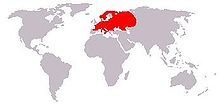European pine marten: Difference between revisions
Vanished User 4517 (talk | contribs) →Gallery: fixed template |
|||
| Line 54: | Line 54: | ||
</gallery> |
</gallery> |
||
{{ |
{{Carnivora|M.}} |
||
[[Category:Martens]] |
[[Category:Martens]] |
||
Revision as of 07:46, 31 December 2008
| European Pine Marten | |
|---|---|

| |
| Scientific classification | |
| Kingdom: | |
| Phylum: | |
| Class: | |
| Order: | |
| Family: | |
| Genus: | |
| Species: | M. martes |
| Binomial name | |
| Martes martes | |

| |
| European Pine Marten range | |
The European Pine Marten (Martes martes), or Pineten, is an animal in the weasel family, native to Northern Europe. It is about the size of a domestic cat. Its body is up to 53 cm in length (21 inches), and its bushy tail can be 25 cm (10 inches). Males are slightly larger than females; on average a marten weighs around 1.5 kg (3.5 lb). Their fur is usually light to dark brown and grows longer and silkier during the winter months. They have a cream to yellow colored "bib" marking on their throats.
Habitat
Their habitats are usually well-wooded areas. European Martens usually make their own dens in hollow trees or scrub-covered fields. Martens are the only mustelids with semi-retractable claws. This enables them to lead more arboreal lifestyles, such as climbing or running on tree branches, although they are also relatively quick runners on the ground. They are mainly active at night and dusk. They have small rounded, highly sensitive ears and sharp teeth for eating small mammals, birds, insects, frogs, and carrion. They have also been known to eat berries, bird's eggs, meat and honey. European Martens are territorial animals, they mark their range by depositing feces in prominent locations.
Threats
Although they are preyed upon occasionally by golden eagles and even more rarely by red foxes, humans are the largest threat to European Pine Martens. Martens are prized for their very fine fur, and loss of habitat leading to fragmentation, persecution by gamekeepers, human disturbance, illegal poisoning and shooting have caused a considerable decline in the European Pine Marten's population. In the United Kingdom, European Pine Martens and their dens are offered full protection under the Wildlife and Countryside Act (1981) and the Environmental Protection Act.
Recently (December, 2007) the European Pine Marten was credited with reducing the population of the invasive Eastern Grey Squirrel in the UK. Where the range of the expanding European Pine Marten population meets that of the Grey Squirrel, the population of the squirrels quickly retreats. It is theorised that because the Grey Squirrel spends more time on the ground than the endangered Red Squirrel, they are far more likely to come in contact with this predator.[1]
Lifespan
The European Pine Marten has lived to 18 years in captivity, but in the wild a lifespan of eight to ten years is more typical. They reach sexual maturity at two or three years of age. The young are usually born in March or April after a month-long gestation period in litters of one to five. Young European Pine Martens weigh around 30 grams at birth. The young begin to emerge out of their dens by the middle of June and are fully independent around six months after their birth.
References
- Aigas Field Centre European Pine Marten ecology page
- Template:IUCN2006
- Wilderness Classroom- Pine Marten
- ARKive Information, movies and images of the European Pine Marten
Notes
- ^ Watson, Jeremy (30 December 2007) "Tufty's saviour to the rescue". Scotland on Sunday. Edinburgh.
Gallery
- tracks on mud
- tracks on snow



